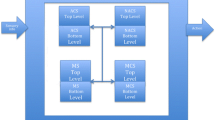Abstract
What can features of cognitive architecture, e.g. the information encapsulation of certain emotion processing systems, tell us about emotional rationality? de Sousa proposes the following hypothesis: “the role of emotions is to supply the insufficiency of reason by imitating the encapsulation of perceptual modes” (de Sousa in The rationality of emotion. MIT Press, Cambridge and London, 1987, p. 195). Very roughly, emotion processing can sometimes occur in a way that is insensitive to what an agent already knows, and such processing can assist reasoning by restricting the response-options she considers. This paper aims to provide an exposition and assessment of de Sousa’s hypothesis. I argue information encapsulation is not essential to emotion-driven reasoning, as emotions can determine the relevance of response-options even without being encapsulated. However, I argue encapsulation can still play a role in assisting reasoning by restricting response-options more efficiently, and in a way that ensures which options emotions deem relevant are not overridden by what the agent knows.
Access this chapter
Tax calculation will be finalised at checkout
Purchases are for personal use only
Similar content being viewed by others
Notes
- 1.
The role attributed to emotions here is similar to that posed later by Damasio (1994). Though, crucially, Damasio doesn’t rely on information encapsulation, nor any other notion from cognitive science. See Brady (2013: §1.2) for a brief overview of accounts that postulate a relation between emotion and salience more generally.
- 2.
- 3.
Chow (2013), for instance, discusses six different versions of the frame problem.
- 4.
de Sousa’s (p. 194) exposition of why the frame problem isn’t the problem of induction also makes explicit that the frame problem he has in mind is one concerning which information is relevant.
- 5.
- 6.
- 7.
This is proposed by several multi-level theories of emotion generation, and confirmed for fear generation at the neurobiological level by LeDoux (1996).
- 8.
A subject might undergo such therapy if trauma has induced debilitating fear responses to walking unaccompanied in dark streets.
References
Barnard, P. 1985. Interacting Cognitive Subsystems: A Psycholinguistic Approach to Short-Term Memory. In Progress in the Psychology of Language, vol. 2, ed. A. Ellis, 197–258. London: Erlbaum.
Brady, M. 2013. Emotional Insight: The Epistemic Role of Emotional Experience. Oxford: Oxford University Press.
Carruthers, P. 2018. Valence and Value. Philosophy and Phenomenological Research 97 (3): 658–680.
Chow, S.J. 2013. What’s the Problem with the Frame Problem? Review of Philosophy and Psychology 4 (2): 309–331.
Colombetti, G. 2005. Appraising Valence. Journal of Consciousness Studies 12 (8–10): 8–10.
Damasio, A.R. 1994. Descartes’ Error: Emotion, Reason, and the Human Brain. New York and London: Putnam and Vintage.
Dennett, D.C. 1984. Cognitive Wheels: The Frame Problem of AI. In Minds, Machines, and Evolution, ed. C. Hookway, 129–152. Cambridge, MA: Cambridge University Press.
de Sousa, R.B. 1987. The Rationality of Emotion. Cambridge and London: MIT Press.
Evans, D. 2002. The Search Hypothesis of Emotions. British Journal for the Philosophy of Science 53 (4): 497–509.
Faucher, L., and C. Tappolet. 2002. Fear and the Focus of Attention. Consciousness and Emotion 3 (2): 105–144.
Fodor, J.A. 1983. The Modularity of Mind. Cambridge and London: MIT Press.
———. 1987. Modules, Frames, Fridgeons, Sleeping Dogs and the Music of the Spheres. In The Robot’s Dilemma: The frame Problem in Artificial Intelligence, ed. Z. Pylyshyn, 139–149. Norwood, NJ: Ablex.
———. 2000. The Mind Doesn’t Work That Way: The Scope and Limits of Computational Psychology. Cambridge, MA: MIT Press.
Greenspan, P.S. (1996). Emotions and Reasons: An Inquiry into Emotional Justification. The Philosophical Quarterly 46 (183): 281.
Ketelaar, T., and P.M. Todd. 2001. Framing Our Thoughts: Ecological Rationality as Evolutionary Psychology’s Answer to the Frame Problem. In Conceptual Challenges in Evolutionary Psychology: Innovative Research Strategies, ed. H.R. Holcomb III, 179–211. Norwell, MA: Kluwer Academic Publishers.
LeDoux, J.E. 1996. The Emotional Brain: The Mysterious Underpinnings of Emotional Life. New York: Simon & Schuster.
Leventhal, H. 1979. A Perceptual-Motor Processing Model of Emotion. In Perception of Emotion in Self and Others, vol. 5, ed. P. Pilner, K. Blankstein, and I.M. Spigel, 1–46. New York: Plenum.
Panksepp, J. 2000. The Neuro-Evolutionary Cusp Between Emotions and Cognitions: Implications for Understanding Consciousness and the Emergence of a Unified Mind Science. Consciousness and Emotion 1 (1): 15–54.
Prinz, J. 2010. For Valence. Emotion Review 2 (1): 5–13.
Solomon, R.C. 1976. The Passions. Garden City, NY: Anchor Press and Doubleday.
———. 1977. The Rationality of Emotions. The Southwestern Journal of Philosophy 8 (2): 105–114.
Teasdale, J. 1999. Multi-level Theories of Cognition-Emotion Relations. In Handbook of Cognition and Emotion, ed. T. Dagleish and M.J. Power, 665–681. New York: Wiley.
Author information
Authors and Affiliations
Corresponding author
Editor information
Editors and Affiliations
Rights and permissions
Copyright information
© 2019 The Author(s)
About this chapter
Cite this chapter
Majeed, R. (2019). What Can Information Encapsulation Tell Us About Emotional Rationality?. In: Candiotto, L. (eds) The Value of Emotions for Knowledge. Palgrave Macmillan, Cham. https://doi.org/10.1007/978-3-030-15667-1_3
Download citation
DOI: https://doi.org/10.1007/978-3-030-15667-1_3
Published:
Publisher Name: Palgrave Macmillan, Cham
Print ISBN: 978-3-030-15666-4
Online ISBN: 978-3-030-15667-1
eBook Packages: Religion and PhilosophyPhilosophy and Religion (R0)




